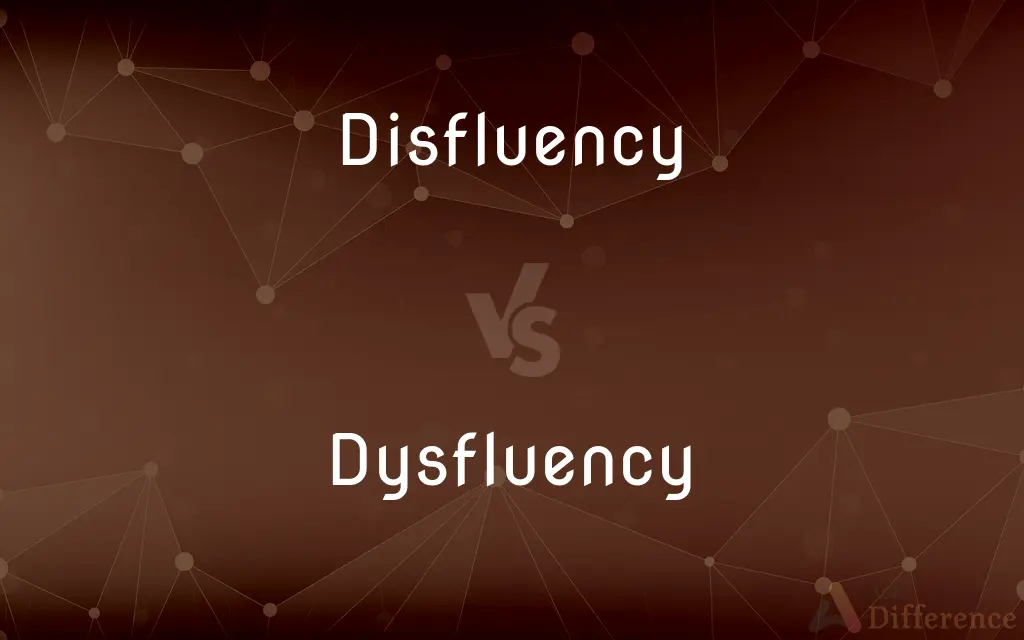Disfluency vs. Dysfluency — What's the Difference?
By Maham Liaqat & Urooj Arif — Updated on April 1, 2024
Disfluency involves breaks or interruptions in speech, while dysfluency refers to speech disorders characterized by such disruption

Difference Between Disfluency and Dysfluency
Table of Contents
ADVERTISEMENT
Key Differences
Disfluency is a general term that describes any kind of interruption or break in the smooth flow of speech, which can occur for various reasons, including pausing for thought, self-correction, or hesitation. Dysfluency, on the other hand, specifically refers to speech disruptions that are part of a speech disorder, such as stuttering, where the flow of speech is involuntarily interrupted.
While disfluency can be observed in the speech patterns of many individuals as a normal part of spoken language, dysfluency is often associated with underlying conditions or disorders that affect speech production. Disfluencies are common and can be considered a normal aspect of speech variation and processing. Dysfluencies, however, can significantly impact communication and may require intervention from speech-language pathologists.
The study of disfluency includes understanding the role of pauses, fillers (like "um" or "uh"), and revisions in speech. These elements can serve various linguistic and cognitive functions, including giving the speaker time to think or aiding the listener in processing speech. Dysfluency, in contrast, may include repetitive sounds or words, prolonged sounds, and involuntary pauses that are symptomatic of specific speech conditions.
Interventions for disfluency typically focus on improving public speaking or communication skills, emphasizing strategies to enhance fluency. For dysfluency, treatment approaches are more specialized and tailored to address the underlying speech disorder, often involving therapeutic techniques to improve speech fluency and confidence.
Disfluency and dysfluency, while related, serve as distinct concepts in the study of speech and language pathology. Disfluency captures the natural variability in speech fluency, while dysfluency highlights pathological speech patterns requiring professional assessment and intervention.
ADVERTISEMENT
Comparison Chart
Definition
Interruptions in the smooth flow of speech, often temporary.
Speech disruptions characteristic of a speech disorder.
Examples
Hesitations, revisions, fillers (e.g., "um", "uh").
Repetitive sounds, prolonged sounds, involuntary pauses.
Occurrence
In the general population, as part of normal speech.
In individuals with speech disorders.
Impact
Generally mild, not significantly hindering communication.
Can significantly impact effective communication.
Treatment
May involve speech training for improvement.
Requires speech therapy to address underlying conditions.
Focus of Study
Linguistic and cognitive functions of speech interruptions.
Pathological speech patterns and their treatment.
Compare with Definitions
Disfluency
Often addressed through public speaking courses or practice.
She improved her speech disfluency by taking a public speaking class.
Dysfluency
Speech disruptions indicative of disorders like stuttering.
The child's dysfluency in speech was diagnosed as stuttering.
Disfluency
Can serve as a pause for thought or to plan what to say next.
His use of disfluency gave him time to collect his thoughts.
Dysfluency
Involuntary, reflecting underlying speech conditions.
Her dysfluency is not just hesitation but a part of her speech condition.
Disfluency
Usually does not significantly affect communication.
Despite occasional disfluencies, his speech was easy to follow.
Dysfluency
Involves specialized speech therapy.
Specialized speech therapy has been effective in managing his dysfluency.
Disfluency
Everyday speech among the general population.
Disfluency is common when people are trying to find the right word.
Dysfluency
Individuals with speech disorders.
Dysfluency is a key symptom in various speech pathology diagnoses.
Disfluency
Natural interruptions in speech, such as hesitations or fillers.
She used um and uh as fillers, showing disfluency in her speech.
Dysfluency
Can hinder effective communication and confidence.
Dysfluency in his speech affected both his communication and self-esteem.
Disfluency
Lack of fluency in speech; any of various breaks, irregularities, and non-lexical vocables that occur within otherwise fluent speech.
Dysfluency
Alt form of disfluency
Common Curiosities
What is disfluency?
Disfluency refers to any interruption in the flow of speech, including hesitations, repetitions, or fillers, often considered a normal part of speech.
What distinguishes dysfluency from disfluency?
Dysfluency specifically relates to speech disruptions caused by speech disorders like stuttering, while disfluency can be a normal speech variation.
Can disfluency become dysfluency?
While disfluency is normal, persistent or severe speech disruptions might indicate a speech disorder, transitioning into what is categorized as dysfluency.
How are dysfluencies treated?
Dysfluencies are treated through speech therapy, focusing on techniques to improve speech fluency and manage symptoms of speech disorders.
Is disfluency always a sign of a speech disorder?
No, disfluency is a common aspect of spoken language and does not necessarily indicate a speech disorder.
What role do fillers play in speech?
Fillers can give speakers time to think and help structure speech, playing a functional role in communication despite being considered disfluencies.
Are there any benefits to disfluency?
Disfluency can aid in cognitive processing for both the speaker and listener by providing pauses that help in organizing and understanding speech.
What strategies are used in speech therapy for dysfluency?
Strategies may include breathing techniques, speech rhythm control, and confidence-building exercises to improve fluency and reduce speech disruptions.
Can stress exacerbate dysfluency?
Yes, stress and anxiety can increase the severity of speech disruptions in individuals with dysfluency.
How does dysfluency affect daily life?
Dysfluency can impact social interactions, professional opportunities, and self-esteem, making effective communication more challenging.
Is there a genetic component to dysfluency?
Research suggests that there can be a genetic predisposition to speech disorders, including those that cause dysfluency.
Can adults have dysfluency?
Yes, adults can experience dysfluency, often as a continuation of childhood speech disorders or due to acquired conditions.
Can technology help with dysfluency?
Yes, there are speech therapy apps and devices designed to assist individuals with dysfluency, providing practice and feedback to improve fluency.
Is there a cure for dysfluency?
While there may not be a "cure" for all types of dysfluency, many individuals can significantly improve their speech fluency through therapy and practice.
How can someone with dysfluency improve their speech?
Improvement often involves working with a speech-language pathologist to develop personalized strategies for managing speech disruptions.
Share Your Discovery

Previous Comparison
Shadow vs. Projection
Next Comparison
Creamer vs. CreamAuthor Spotlight
Written by
Maham LiaqatCo-written by
Urooj ArifUrooj is a skilled content writer at Ask Difference, known for her exceptional ability to simplify complex topics into engaging and informative content. With a passion for research and a flair for clear, concise writing, she consistently delivers articles that resonate with our diverse audience.














































